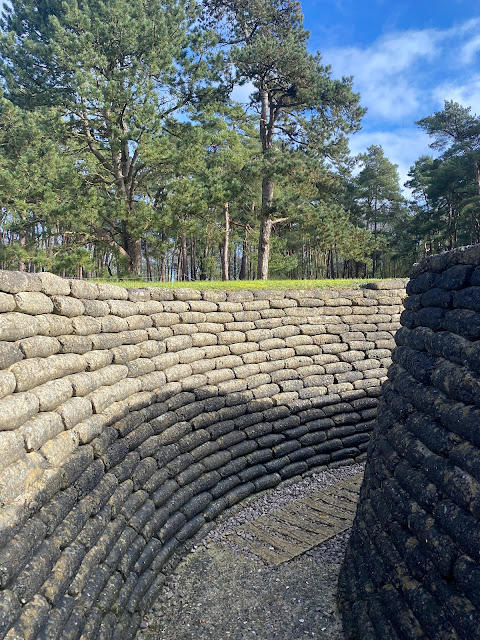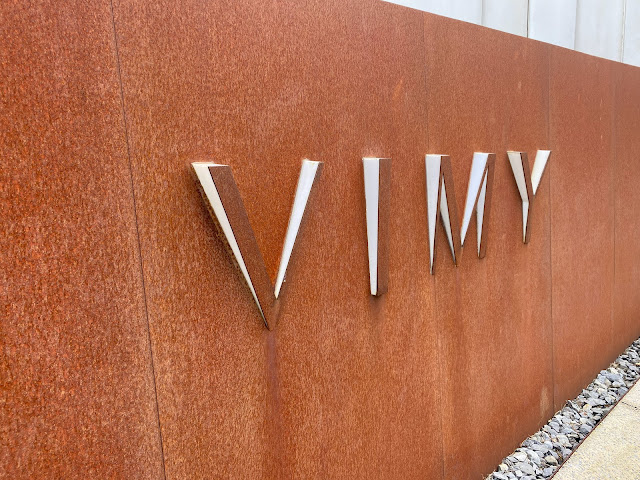Vimy Ridge - 50° 22' 17" N 02° 46' 21" E
Our route from Mons to Cherbourg took us past Vimy Ridge so we stopped to tour the memorial. For the Australians reading this, Vimy Ridge is Canada's Gallipoli. It was the first time all four Canadian Divisions had attacked together and men from all over Canada involved. Similar to Gallipoli, it is considered the birth of the nation - but, unlike at Gallipoli, the Canadians won and took the ridge!
The Canadian National Vimy Memorial is 100 hectares of battlefield that France has ceded to Canada in perpetuity. It is preserved as a park, managed and run by Canada. The guides are all Canadian post-secondary students employed under a Veteran Affairs program - Student Guides in France. Visits are free and the guided tour, which included going into the tunnels, was excellent.
Vimy Ridge is a high point in the area and overlooks the plains below for kilometres in every direction. The Germans had held this high point and had defended it against repeated attacks for most of the war. In April 1917, the Canadians managed to take the ridge after learning lessons from the unsuccessful French attacks and with assistance from British tunnellers, air reconnaissance (primitive and very dangerous in those days) and artillery.
They undertook months of training in models of the trench system. It was also one of the first battles that everyone (not just the officers) knew the objectives. Trench maps were passed out to all ranks. This meant that the soldiers could effectively continue the attack even if their officers were killed.
 |
| These are the German front lines - the Canadian trenches start under the Canadian flag. Only about 20m separated them. |
 |
| Map of the tunnels - both German and Allied. You can see how close they were. |
We toured the tunnels and the trenches with an excellent guide. Much of the park is restricted due to the shell holes and unexploded ordinances - and likely a great number of bodies - blown up, sucked into the mud and never found. The craters and shell holes have been left with the regrown grass and trees making it serene and park-like. Even with the chirping of birds and the sun filtering through the trees, the true horror can still be felt.
 |
| Inside the tunnels - they were much darker with just a 20 watt globe every 50m or so. |
 |
| There was many bits of grafitti from the soldiers who spent days in the tunnels. Seeing it made the soldiers of the past feel much more present. Wonder if this fella survived... |
 |
| The trenches have been tidied up with concrete sandbags and duckboards and gravel to combat the mud but you can still get a feel for the exposure. |
 |
| The shell holes have been left, the grass and trees have grown since the war. This would have just been mud for as far as the eye can see. |
All the war literature and writings make mention of the mud and it was one thing completely lacking at the Memorial. You can get a feel of it by the water in the bottom of the shell-holes and the surrounding ploughed farmers' fields. But you need to look and imagine. Below is a photo that shows the conditions. It was colourised as part of a 2018 project by the Vimy Foundation. The colour photos help us visualise how frightful the conditions must have been. Imagine slipping into a shell-hole and how difficult it would be to get out, even uninjured.
 |
| This photo was taken in Belguim, Canadian and German wounded helping each other through the mud. Photo credit to the Vimy Foundation |
Casualties were high on both sides and the cemeteries from earlier battles were lost in subsequent fighting. Many, many of the dead have no known grave and so they are named on the Vimy Memorial. Over 11,000 Canadian names are carved around the perimeter - every Canadian who died in France without a known grave.
 |
| The Vimy Memorial |
Continuing our drive through the areas of the Western Front, it started to rain. We were snug and warm with our seat heaters on in our rental car looking out on the windswept fields. And the number of cemeteries with their white crosses scattered around the landscape. It must have been hell.

Comments
Post a Comment